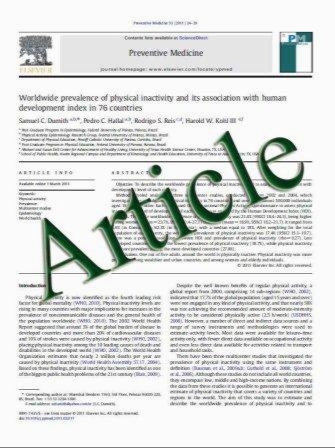Estrogen and muscle stiffness have a negative relationship in females
- نوع فایل : کتاب
- زبان : انگلیسی
- مؤلف : David R. Bell • J. Troy Blackburn • Marc F. Norcorss • Kristin S. Ondrak • Jeffery D. Hudson • A. C. Hackney • Darin A. Padua
- چاپ و سال / کشور: 2011
Description
Purpose Hormonal fluctuations are one potential reason why females might have a greater rate of noncontact ACL injury. The hamstrings are capable of limiting anterior cruciate ligament (ACL) loading. This study examined whether relationships existed between reproductive hormones (estradiol-b-17, free testosterone, and progesterone) and hamstring neuromechanical variables (hamstring musculotendinous stiffness (MTS), rate of force production (RFP), time to 50% peak torque (T50%), and electromechanical delay (EMD)) in genders combined and independently. Methods Muscle properties of the hamstrings and reproductive hormones were evaluated in 30 subjects (15 males and 15 females) that were free from lower extremity injury and had no history of ACL injury. Females were tested 3–5 days after the onset of menses and were not using oral contraceptive. Pearson correlation coefficients were calculated for each hormone and muscle property. Results For genders combined, estrogen (mean = 46.0 ± 28.2 pg/mL) was negatively correlated with RFP (mean = 758.8 ± 507.6 N/kg s-1, r = -0.43, P = 0.02) and MTS (mean = 12.8 ± 2.6 N/cm, r = -0.43, P = 0.02). Free testosterone (mean = 13.2 ± 13.0 pg/ mL) was positively correlated with RFP (r = 0.56, P\0.01) and MTS (r = 0.46, P = 0.01) but negatively correlated with T50% (mean = 114.7 ± 38.9 ms, r = -0.43, P = 0.02). When gender was considered separately, females demonstrated negative correlation between estrogen (mean = 68.0 ± 23.2 pg/mL) and MTS (mean = 11.7 ± 1.5 N/cm, r = -0.53, P = 0.05) and free testosterone (mean = 1.5 ± 0.6 pg/mL) and MTS (r = -0.52, P = 0.05). Males alone displayed no significant correlations between the selected hormones and muscle properties. Conclusions Correlations exist between muscle properties and reproductive hormones. Females, however, may be more sensitive to reproductive hormones and their fluctuations
Knee Surg Sports Traumatol Arthrosc DOI 10.1007/s00167-011-1577-y Received: 11 August 2010 / Accepted: 9 June 2011


